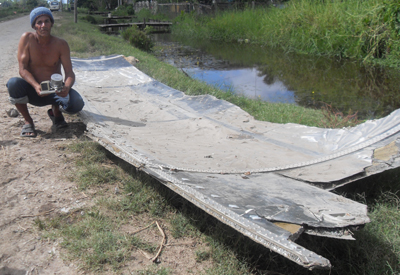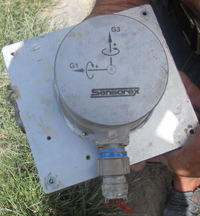
Wreckage of the French Airbus
Dennis Baksh, a farmer from Ann’s Grove, East Coast Demerara, knew that he had stumbled on to something valuable last Friday whilst on the Hope Beach.
Baksh had found what is believed to be a part of the fuselage and a component believed to be the first piece of sensory equipment recovered from Air France Airbus A330-200 that crashed into the Atlantic Ocean after leaving neighbouring Brazil en route to France on June 1.
According to Baksh, he immediately realized that what he had found was not a part of a boat and as such made arrangements to have a tractor haul the piece of debris to his home, some distance inland.
“I see it pun deh seawall and when a go and check I say that this got to be a part of a plane,” said Baksh, yesterday
Baksh had found what is believed to be a part of the fuselage and a component believed to be the first piece of sensory equipment recovered from Air France Airbus A330-200 that crashed into the Atlantic Ocean after leaving neighbouring Brazil en route to France on June 1.
According to Baksh, he immediately realized that what he had found was not a part of a boat and as such made arrangements to have a tractor haul the piece of debris to his home, some distance inland.
“I see it pun deh seawall and when a go and check I say that this got to be a part of a plane,” said Baksh, yesterday

Sensory Device found at Hope Beach
The man who made the important discovery said that he did not see any other piece of debris in the area.
The sensory component that was attached to the fuselage is a three-axis Inertial Measurement Unit (IMU) which is cylindrical in shape and is mounted on a flat base with electrical wiring protruding from within it. It bears the trademark ‘Sensorex.’
Baksh attempted to open the device but only managed to break into the cylindrical case; the cube within was impenetrable to Baksh.
A GCAA official said that he noted the numbers on the fuselage and on the equipment marked Sensorex and that he would be forwarding these to the relevant authorities.
Another aviation official explained that the piece of equipment marked Sensorex might be the first piece of sensory equipment retrieved from the crashed plane. He explained that it sends signals to the flight panel and this might be the piece of malfunctioning equipment that caused the crash.
An Inertial Measurement Unit (IMU) is the main component of inertial guidance systems used in air, space, and watercraft, including guided missiles.
An IMU works by sensing motion including the type, rate, and direction of that motion using a combination of accelerometers and gyroscopes.
The data collected from these sensors allows a computer to track a craft’s position, using a method known as dead reckoning.
The IMU works by detecting the current rate of acceleration, as well as changes in rotational attributes, including pitch, roll and yaw.
The data is then fed into a computer, which calculates the current speed and position, given a known initial speed and position.
The sensory component that was attached to the fuselage is a three-axis Inertial Measurement Unit (IMU) which is cylindrical in shape and is mounted on a flat base with electrical wiring protruding from within it. It bears the trademark ‘Sensorex.’
Baksh attempted to open the device but only managed to break into the cylindrical case; the cube within was impenetrable to Baksh.
A GCAA official said that he noted the numbers on the fuselage and on the equipment marked Sensorex and that he would be forwarding these to the relevant authorities.
Another aviation official explained that the piece of equipment marked Sensorex might be the first piece of sensory equipment retrieved from the crashed plane. He explained that it sends signals to the flight panel and this might be the piece of malfunctioning equipment that caused the crash.
An Inertial Measurement Unit (IMU) is the main component of inertial guidance systems used in air, space, and watercraft, including guided missiles.
An IMU works by sensing motion including the type, rate, and direction of that motion using a combination of accelerometers and gyroscopes.
The data collected from these sensors allows a computer to track a craft’s position, using a method known as dead reckoning.
The IMU works by detecting the current rate of acceleration, as well as changes in rotational attributes, including pitch, roll and yaw.
The data is then fed into a computer, which calculates the current speed and position, given a known initial speed and position.

No comments:
Post a Comment